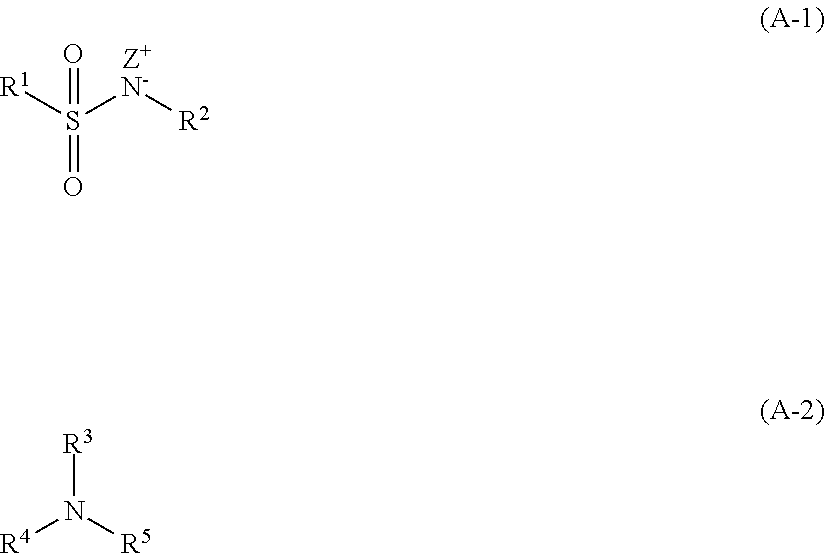Pattern forming method and developer
- Summary
- Abstract
- Description
- Claims
- Application Information
AI Technical Summary
Benefits of technology
Problems solved by technology
Method used
Image
Examples
synthesis example 1
[Synthesis Example 1] (Synthesis of Polymer (A-1))
[0288]Compound (M-3), compound (M-4), compound (M-5), and compound (M-6) as monomers were dissolved in 2-butanone (200 parts by mass) so that the molar ratio thereof was 55 / 5 / 20 / 20. Azobisisobutyronitrile (AIBN) (3% by mole) as an initiator was added to this to prepare a monomer solution. 2-Butanone (100 parts by mass) was placed in a reaction vessel. The internal temperature of the reaction vessel was set to 80° C., and the monomer solution was added into the reaction vessel dropwise over 3 hours while performing stirring. The polymerization reaction was conducted for 6 hours with the start of dropwise addition being the start time of the polymerization reaction. After completion of the polymerization reaction, the polymerization solution was cooled with water to 30° C. or less. The cooled polymerization solution was poured into methanol (2000 parts by mass), and the precipitated white powder was separated by filtration. The separat...
synthesis example 2
[Synthesis Example 2] (Synthesis of Polymer (A-2))
[0289]Compound (M-3), compound (M-4), compound (M-5), and compound (M-6) as monomers were dissolved in 2-butanone (200 parts by mass) so that the molar ratio thereof was 55 / 5 / 20 / 20. AIBN (7% by mole) as an initiator was added to this to prepare a monomer solution. 2-Butanone (100 parts by mass) was placed in a reaction vessel. The internal temperature of the reaction vessel was set to 80° C., and the monomer solution was added into the reaction vessel dropwise over 3 hours while performing stirring. The polymerization reaction was conducted for 6 hours with the start of dropwise addition being the start time of the polymerization reaction. After completion of the polymerization reaction, the polymerization solution was cooled with water to 30° C. or less. The cooled polymerization solution was poured into methanol (2000 parts by mass), and the precipitated white powder was separated by filtration. The separated white powder was washe...
synthesis example 3
[Synthesis Example 3] (Synthesis of Polymer (A-3))
[0290]Compound (M-3), compound (M-5), and compound (M-6) as monomers were dissolved in 2-butanone (200 parts by mass) so that the molar ratio thereof was 60 / 20 / 20. AIBN (5% by mole) as an initiator was added to this to prepare a monomer solution. 2-Butanone (100 parts by mass) was placed in a reaction vessel. The internal temperature of the reaction vessel was set to 80° C., and the monomer solution was added into the reaction vessel dropwise over 3 hours while performing stirring. The polymerization reaction was conducted for 6 hours with the start of dropwise addition being the start time of the polymerization reaction. After completion of the polymerization reaction, the polymerization solution was cooled with water to 30° C. or less. The cooled polymerization solution was poured into methanol (2000 parts by mass), and the precipitated white powder was separated by filtration. The separated white powder was washed with methanol tw...
PUM
 Login to View More
Login to View More Abstract
Description
Claims
Application Information
 Login to View More
Login to View More - R&D
- Intellectual Property
- Life Sciences
- Materials
- Tech Scout
- Unparalleled Data Quality
- Higher Quality Content
- 60% Fewer Hallucinations
Browse by: Latest US Patents, China's latest patents, Technical Efficacy Thesaurus, Application Domain, Technology Topic, Popular Technical Reports.
© 2025 PatSnap. All rights reserved.Legal|Privacy policy|Modern Slavery Act Transparency Statement|Sitemap|About US| Contact US: help@patsnap.com



